Tree-Ring Stable Carbon Isotope-Based Mean Maximum Temperature Reconstruction in Northwest China and Its Connection with Atmospheric Circulations
Abstract
1. Introduction
2. Materials and Methods
2.1. The Study Site and Sampling
2.2. The Developing of Stable Carbon Isotope Chronology
2.3. Climatic and Ejina Oasis Area Data
2.4. Statistical Methods
3. Results
3.1. Statistical Analysis of Stable Carbon Isotope Chronology
3.2. Climate Response of Tree-Ring Stable Carbon Isotope
3.3. Transfer Function and Verification
3.4. Mean Maximum Temperature Reconstruction
3.5. Spatial Representativeness and Periodicities
3.6. Comparison with the Ejina Oasis Area
4. Discussion
4.1. Chronology Characteristics of Stable Carbon Isotopes
4.2. Relationship between Climate and Tree-Ring ∆13C
4.3. Local and Regional Climate Characteristics
4.4. Relationship with the Ejina Oasis Area
4.5. Linkages with Large Scale Atmospheric Circulations
5. Conclusions
Author Contributions
Funding
Institutional Review Board Statement
Informed Consent Statement
Data Availability Statement
Conflicts of Interest
References
- Zhao, Y.; Guo, J.; Mao, K.; Xiang, Y.; Li, Y.; Han, J.; Wu, N. Spatio-temporal distribution of typical natural disasters and grain disaster losses in China from 1949 to 2015. Acta Geogr. Sin. 2017, 72, 1261–1276. [Google Scholar]
- Loader, N.; Young, G.; Grudd, H.; McCarroll, D. Stable carbon isotopes from Torneträsk, northern Sweden provide a millennial length reconstruction of summer sunshine and its relationship to Arctic circulation. Quat. Sci. Rev. 2013, 62, 97–113. [Google Scholar] [CrossRef]
- Zhao, X.; Zheng, Z.; Shang, Z.; Wang, J.; Cheng, R.; Qian, J. Climatic information recorded in stable carbon isotopes in tree rings of Cryptomeria fortunei, Tianmu Mountain, China. Dendrochronologia 2014, 32, 256–265. [Google Scholar] [CrossRef]
- Liu, Y.; Wang, Y.; Li, Q.; Song, H.; Linderholm, H.W.; Leavitt, S.W.; Wang, R.; An, Z. Tree-ring stable carbon isotope-based May–July temperature reconstruction over Nanwutai, China, for the past century and its record of 20th century warming. Quat. Sci. Rev. 2014, 93, 67–76. [Google Scholar] [CrossRef]
- Liu, Y.; Ta, W.; Li, Q.; Song, H.; Sun, C.; Cai, Q.; Liu, H.; Wang, L.; Hu, S.; Sun, J.; et al. Tree-ring stable carbon isotope-based April–June relative humidity reconstruction since ad 1648 in Mt. Tianmu, China. Clim. Dynam. 2018, 50, 1733–1745. [Google Scholar] [CrossRef]
- Li, D.; Fang, K.; Li, Y.; Chen, D.; Liu, X.; Dong, Z.; Zhou, F.; Guo, G.; Shi, F.; Xu, C.; et al. Climate, intrinsic water-use efficiency and tree growth over the past 150 years in humid subtropical China. PLoS ONE 2017, 12, e0172045. [Google Scholar] [CrossRef]
- Zeng, X.; Liu, X.; Treydte, K.; Evans, M.N.; Wang, W.; An, W.; Sun, W.; Xu, G.; Wu, G.; Zhang, X. Climate signals in tree-ring δ18O and δ13C from southeastern Tibet: Insights from observations and forward modelling of intra- to interdecadal variability. New Phytol. 2017, 216, 1104–1118. [Google Scholar] [CrossRef]
- Wang, W.; Liu, X.; Xu, G.; Zeng, X.; Wu, G.; Zhang, X.; Qin, D. Temperature signal instability of tree-ring δ 13 C chronology in the northeastern Qinghai–Tibetan Plateau. Glob. Planet. Chang. 2016, 139, 165–172. [Google Scholar] [CrossRef]
- Kang, S.; Loader, N.J.; Wang, J.; Qin, C.; Liu, J.; Song, M. Tree-Ring Stable Carbon Isotope as a Proxy for Hydroclimate Vari-ations in Semi-Arid Regions of North-Central China. Forests 2022, 13, 492. [Google Scholar] [CrossRef]
- Heinrich, I.; Touchan, R.; Liñán, I.D.; Vos, H.; Helle, G. Winter-to-spring temperature dynamics in Turkey derived from tree rings since AD 1125. Clim. Dyn. 2013, 41, 1685–1701. [Google Scholar] [CrossRef]
- Barbour, M.M.; Walcroft, A.S.; Farquhar, G.D. Seasonal variation in δ13C and δ18O of cellulose from growth rings of Pinus radiata. Plant Cell Environ. 2002, 25, 1483–1499. [Google Scholar] [CrossRef]
- Francey, R.J.; Farquhar, G. An explanation of 13C/12C variations in tree rings. Nature 1982, 297, 28–31. [Google Scholar] [CrossRef]
- Wang, W.; Liu, X.; Shao, X.; Leavitt, S.; Xu, G.; An, W.; Qin, D. A 200 year temperature record from tree ring δ13C at the Qaidam Basin of the Tibetan Plateau after identifying the optimum method to correct for changing atmospheric CO2 and δ13C. J. Geophys. Res. 2011, 116, 4022. [Google Scholar] [CrossRef]
- Liu, P.; Chen, F.; Gou, X.; Peng, J.; Huang, X. Establishment of Tree-ring Chronology and Response Analysis in Past 100 Years for Ejin Banner, Inner Mongolia. J. Desert Res. 2005, 25, 764–768. (In Chinese) [Google Scholar]
- Liu, X.; Wang, W.; Xu, G.; Zeng, X.; Wu, G.; Zhang, X.; Qin, D. Tree growth and intrinsic water-use efficiency of inland ri-parian forests in northwestern China: Evaluation via δ13C and δ18O analysis of tree rings. Tree Physiol. 2014, 34, 966–980. [Google Scholar] [CrossRef]
- Sun, J.; Liu, Y.; Cai, Q.; Park, W.K.; Li, B.; Shi, J.; Yi, L.; Song, H.; Li, Q. Climatic and hydrological changes of Ejin, Inner Mongolia, China during the past 233 years recorded in tree-rings of Populus euphratica. Quat. Sci. 2006, 26, 799–807. (In Chinese) [Google Scholar]
- Liu, P.; Chen, F.; Jin, L.; Gou, X.; Zhang, Y.; Peng, J. About 100-year reconstruction of spring stream flow based on tree ring in the lower reaches of Heihe Rive. Arid. Land Geogr. 2007, 50, 696–700. (In Chinese) [Google Scholar]
- Li, Q.; Liu, Y.; Meko, D.M.; Nakatsuka, T.; Pan, Y.; Song, H.; Liu, R.; Sun, C.; Fang, C. Water Resource Management Implica-tions for a Desert Oasis From Tree-Ring δ18O Variations in Populus Euphratica in Northwest China. Water Resour. Res. 2022, 58, e2022WR031953. [Google Scholar] [CrossRef]
- Photiadou, C. Extreme Precipitation and Temperature Responses to Circulation Patterns in Current Climate: Statistical Approaches. Ph.D. Thesis, Utrecht University, Utrecht, The Netherlands, 2015. [Google Scholar]
- Cantelaube, P.; Terres, J.; Doblas-Reyes, F.J. Climate variability influences on European agriculture. Analysis for winter wheat production. Clim. Res. 2004, 27, 135–144. [Google Scholar] [CrossRef]
- Liu, Y.; Wang, Y.; Li, Q.; Sun, J.; Song, H.; Cai, Q.; Zhang, Y.; Yuan, Z.; Wang, Z. Reconstructed May–July mean maximum temperature since 1745AD based on tree-ring width of Pinus tabulaeformis in Qianshan Mountain, China. Palaeogeogr. Palaeoclim. Palaeoecol. 2013, 388, 145–152. [Google Scholar] [CrossRef]
- Ren, J.; Liu, Y.; Song, H.; Ma, Y.; Li, Q.; Wang, Y.; Cai, Q. The historical reconstruction of the maximum temperature over the past 195 years, linxia region, gansu province—Based on the data from Picea purpurea. Mast. Quarter. Sci. 2014, 34, 1270–1279. (In Chinese) [Google Scholar]
- Peng, X.; Xiao, S.; Cheng, G.; Xiao, H.; Tian, Q.; Zhang, Q. Human activity impacts on the stem radial growth of Populus euphratica riparian forests in China’s Ejina Oasis, using tree-ring analysis. Trees 2017, 31, 379–392. [Google Scholar] [CrossRef]
- Yu, W. Characteristics of Phenology and Physiological Ecology of Populus euphratica Oliv. in Ejina; Beijing Forestry University: Bejing, China, 2012; pp. 27–28. (In Chinese) [Google Scholar]
- Kang, X. The restrictive factors and the development strategies of forest restoration of Populus euphratica Oliv. in Gansu. J. Desert Res. 1997, 17, 53–57. (In Chinese) [Google Scholar]
- Leavitt, S.W. Tree-ring C–H–O isotope variability and sampling. Sci. Total Environ. 2010, 408, 5244–5253. [Google Scholar] [CrossRef]
- Leavitt, S.W.; Long, A. Sampling strategy for stable carbon isotope analysis of tree rings in pine. Nature 1984, 311, 145–147. [Google Scholar] [CrossRef]
- Leavitt, S.W.; Lara, A. South American tree rings show declining δ13C trend. Tellus B 1994, 46, 152–157. [Google Scholar] [CrossRef]
- McCarroll, D.; Loader, N.J. Stable isotopes in tree rings. Quat. Sci. Rev. 2004, 23, 771–801. [Google Scholar] [CrossRef]
- Treydte, K.S.; Frank, D.C.; Saurer, M.; Helle, G.; Schleser, G.H.; Esper, J. Impact of climate and CO2 on a millennium-long tree-ring carbon isotope record. Geochim. Cosmochim. Acta 2009, 73, 4635–4647. [Google Scholar] [CrossRef]
- Easterling, D.R.; Peterson, T.C. A new method for detecting and adjusting for undocumented discontinuities in climatological time series. Int. J. Climatol. 1995, 15, 369–377. [Google Scholar] [CrossRef]
- Bao, G.; Liu, Y.; Liu, N.; Linderholm, H. Drought variability in eastern Mongolian Plateau and its linkages to the large-scale climate forcing. Clim. Dyn. 2014, 44, 717–733. [Google Scholar] [CrossRef]
- Chen, Z.J.; Zhang, X.L.; Cui, M.X.; He, X.Y.; Ding, W.H.; Peng, J.J. Tree-ring based precipitation reconstruction for the for-est-steppe ecotone in northern Inner Mongolia, China and its linkages to the Pacific Ocean variability. Glob. Planet. Chang. 2012, 86–87, 45–56. [Google Scholar] [CrossRef]
- Trouet, V.; Esper, J.; Graham, N.E.; Baker, A.; Scourse, J.D.; Frank, D.C. Persistent Positive North Atlantic Oscillation Mode Dominated the Medieval Climate Anomaly. Science 2009, 324, 78–80. [Google Scholar] [CrossRef]
- Biondi, F.; Gershunov, A.; Cayan, D.R. North Pacific decadal climate variability since 1661. J. Clim. 2001, 14, 5–10. [Google Scholar] [CrossRef]
- D’Arrigo, R.D.; Cook, E.R.; Mann, M.E.; Jacoby, G.C. Tree-ring reconstructions of temperature and sea-level pressure variability associated with the warm-season Arctic Oscillation since AD 1650. Geophys. Res. Lett. 2003, 30, 1549. [Google Scholar] [CrossRef]
- Xie, Y.; Jiang, H.; Xueqiang, W.; Ma, Z.; Chen, Y. Spatial-temporal changes of oases in Ejin Banner of the Heihe River Basin from 1963 to 2012. Arid. Land Geogr. 2014, 37, 776–792. (In Chinese) [Google Scholar]
- Fritts, H.C. Tree Rings and Climate; Blackburn Press: Caldwell, NJ, USA; Academic Press: London, UK, 2001; pp. 1–567. [Google Scholar]
- Fritts, H.C. Reconstructing Large-Scale Climatic Patterns from Tree-Ring Data; The University of Arizona Press: Tucson, AZ, USA, 1991; p. 286. [Google Scholar]
- Efron, B. Bootstrap Methods: Another Look at the Jackknife. Ann. Stat. 1979, 7, 1–26. [Google Scholar] [CrossRef]
- Mosteller, F.; Tukey, J.W. Data Analysis and Regression. A Second Course in Statistics; Addison-Wesley Series in Behavioral Science: Quantitative Methods, Reading; Addison-Wesley: Boston, MA, USA, 1977. [Google Scholar]
- Mann, M.E.; Lees, J.M. Robust estimation of background noise and signal detection in climatic time series. Clim. Chang. 1996, 33, 409–445. [Google Scholar] [CrossRef]
- Cook, E.R.; Meko, D.M.; Stahle, D.W.; Cleaveland, M.K. Drought reconstructions for the continental United States. J. Clim. 1999, 12, 1145–1162. [Google Scholar] [CrossRef]
- Durbin, J.; Watson, G.S. Testing for serial correlation in least squares regression. II. Biometrika 1951, 38, 159–179. [Google Scholar] [CrossRef]
- Porté, A.; Loustau, D. Seasonal and interannual variations in carbon isotope discrimination in a maritime pine (Pinus pinaster) stand assessed from the isotopic composition of cellulose in annual rings. Tree Physiol. 2001, 21, 861–868. [Google Scholar] [CrossRef]
- Lü, S.; Wang, X. Growth-climate response and winter precipitation reconstruction of Pinus sylvestris var. mongolicain A’li River of Greater Khingan Range. J. Northeast Normal Univ. Nat. Sci. Ed. 2014, 46, 110–116. (In Chinese) [Google Scholar]
- Farquhar, G.D.; Sharkey, T.D. Stomatal conductance and photosynthesis. Annu. Rev. Plant Physiol. 1982, 33, 317–345. [Google Scholar] [CrossRef]
- Yi, L.; Yu, H.; Ge, J.; Lai, Z.; Xu, X.; Qin, L.; Peng, S. Reconstructions of annual summer precipitation and temperature in north-central China since 1470 AD based on drought/flood index and tree-ring records. Clim. Chang. 2011, 110, 469–498. [Google Scholar] [CrossRef]
- Zhou, W.; Sun, Z.; Li, J.; Gang, C.; Zhang, C. Desertification dynamic and the relative roles of climate change and human activities in desertification in the Heihe River Basin based on NPP. J. Arid Land 2013, 5, 465–479. [Google Scholar] [CrossRef]
- Bao, G.; Liu, Y.; Linderholm, H.W. April-September mean maximum temperature inferred from Hailar pine (Pinus syl-vestris var. mongolica) tree rings in the Hulunbuir region, Inner Mongolia, back to 1868 AD. Palaeogeogr. Palaeoclimatol. Palaeoecol. 2012, 313, 162–172. [Google Scholar] [CrossRef]
- Liu, N.; Liu, Y.; Bao, G.; Bao, M.; Wang, Y.; Ge, Y.; Zhang, L.; Bao, W.; Tian, H. A tree-ring based reconstruction of summer relative humidity variability in eastern Mongolian Plateau and its associations with the Pacific and Indian Oceans. Palaeogeogr. Palaeoclim. Palaeoecol. 2015, 438, 113–123. [Google Scholar] [CrossRef]
- Liu, Y.; Wang, Y.; Li, Q.; Song, H.; Zhang, Y.; Yuan, Z.; Wang, Z. A tree-ring-based June-September mean relative humidity reconstruction since 1837 from the Yiwulü Mountain region, China. Int. J. Clim. 2015, 35, 1301–1308. [Google Scholar] [CrossRef]
- Allan, R.J.; Lindesay, J.A.; Parker, D.E. El Nino Southern Oscillation and Climatic Variability; CSIRO Publishing: Collingwood, Australia, 1996. [Google Scholar]
- Su, M.; Wang, H. Relationship and its instability of ENSO—Chinese variations in droughts and wet spells. Sci. China Ser. D Earth Sci. 2007, 50, 145–152. [Google Scholar] [CrossRef]
- Zhang, R.; Sumi, A.; Kimoto, M. A diagnostic study of the impact of El Niño on the precipitation in China. Adv. Atmos. Sci. 1999, 16, 229–241. [Google Scholar] [CrossRef]
- Lu, R.Y. Interannual variation of North China rainfall in rainy season and SSTs in the equatorial eastern Pacific. Chin. Sci. Bull. 2005, 50, 2069–2073. [Google Scholar] [CrossRef]
- Li, K. The shape of the sunspot cycle described by sunspot areas. Astron. Astrophys. 1999, 345, 1006–1010. [Google Scholar]
- Halberg, F.; Cornélissen, G.; Sothern, R.B.; Czaplicki, J.; Schwartzkopff, O. Thirty-five-year climatic cycle in heliogeophys-ics, psychophysiology, military politics, and economics. Izv. Atmos. Ocean. Phys. 2010, 46, 844–864. [Google Scholar] [CrossRef]
- Auer, G.; Piller, W.E.; Harzhauser, M. Two distinct decadal and centennial cyclicities forced marine upwelling intensity and precipitation during the late Early Miocene in central Europe. Clim. Past 2015, 11, 283–303. [Google Scholar] [CrossRef]
- Nagovitsyn, Y.A. Solar activity during the last two millennia: Solar patrol in ancient and medieval China. Geomagn. Aeron. 2001, 41, 680–688. [Google Scholar]
- Ogurtsov, M.G.; Nagovitsyn, Y.A.; Kocharov, G.E.; Jungne, R.H. Long-period cycles of the Sun’s activity recorded in direct solar data and proxies. Sol. Phys. 2002, 211, 371–394. [Google Scholar] [CrossRef]
- Fu, C.; Zheng, Z. Monsoon regions: The highest rate of precipitation changes observed from global data. Chin. Sci. Bull. 1998, 43, 662–666. [Google Scholar] [CrossRef]
- Balachandran, N.K.; Rind, D.; Lonergan, P.; Shindell, D. Effects of solar cycle variability on the lower stratosphere and the troposphere. J. Geophys. Res. Earth Surf. 1999, 104, 27321–27339. [Google Scholar] [CrossRef]
- Sutton, R.T.; Hodson, D.L.R. Atlantic Ocean Forcing of North American and European Summer Climate. Science 2005, 309, 115–118. [Google Scholar] [CrossRef]
- Li, C.; Wang, L.; Gu, W. Interannual time-scale relationship between Mongolia high and SST anomaly in the North Pacific in winter. Chin. J. Atmos. Sci. 2011, 35, 193–200. (In Chinese) [Google Scholar]
- Wu, B.; Wang, J. Possible impacts of winter Arctic Oscillation on Siberian high, the East Asian winter monsoon and sea-ice extent. Adv. Atmos. Sci. 2002, 19, 297–320. [Google Scholar]
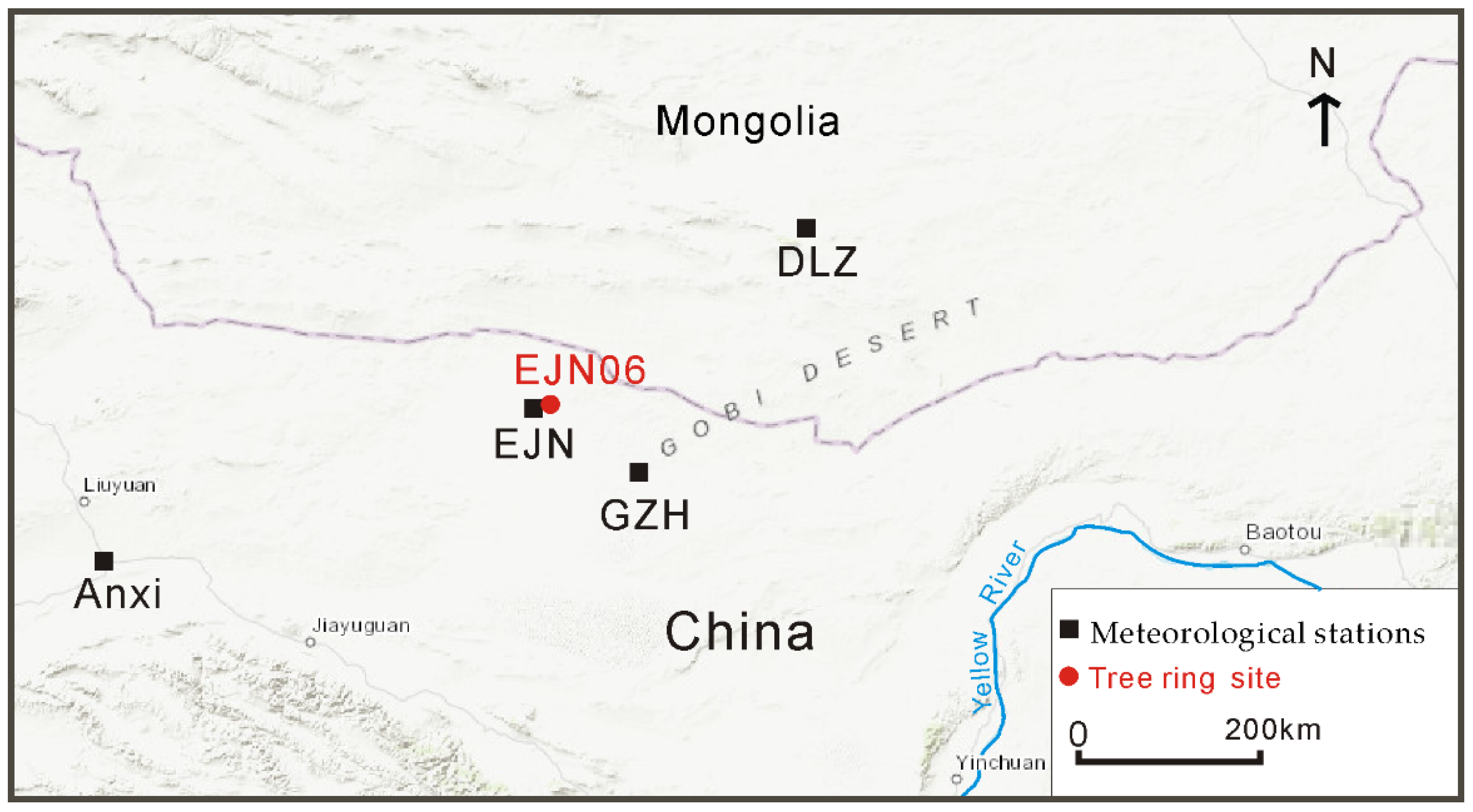
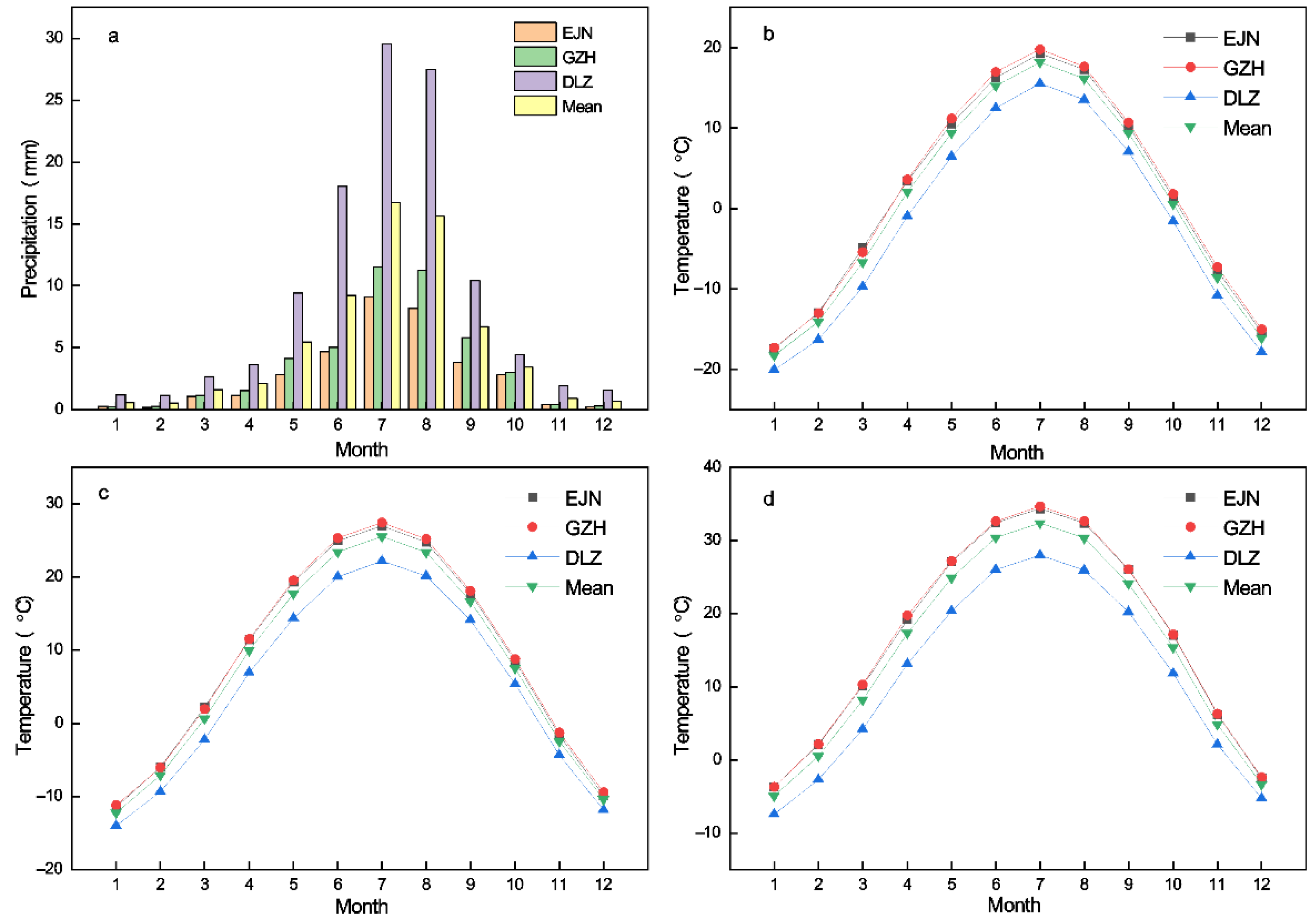

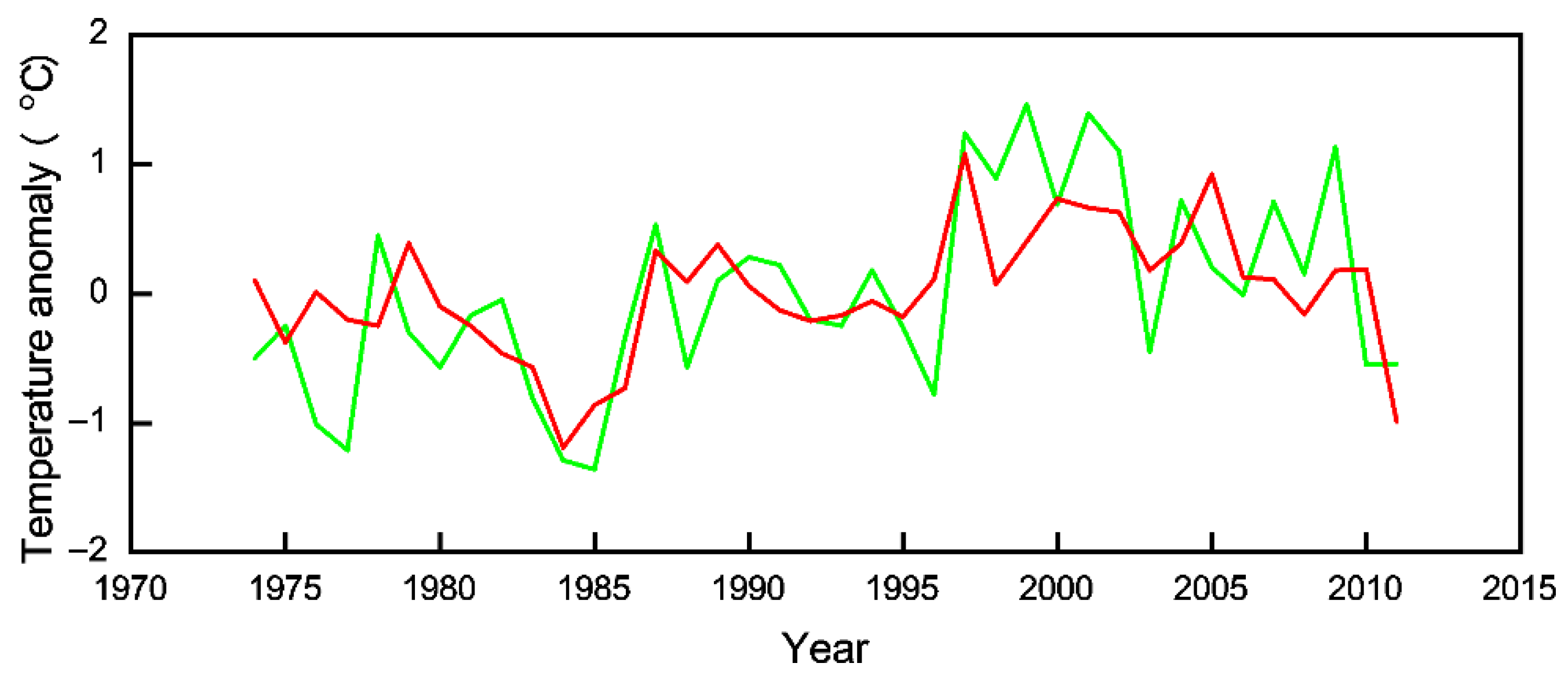
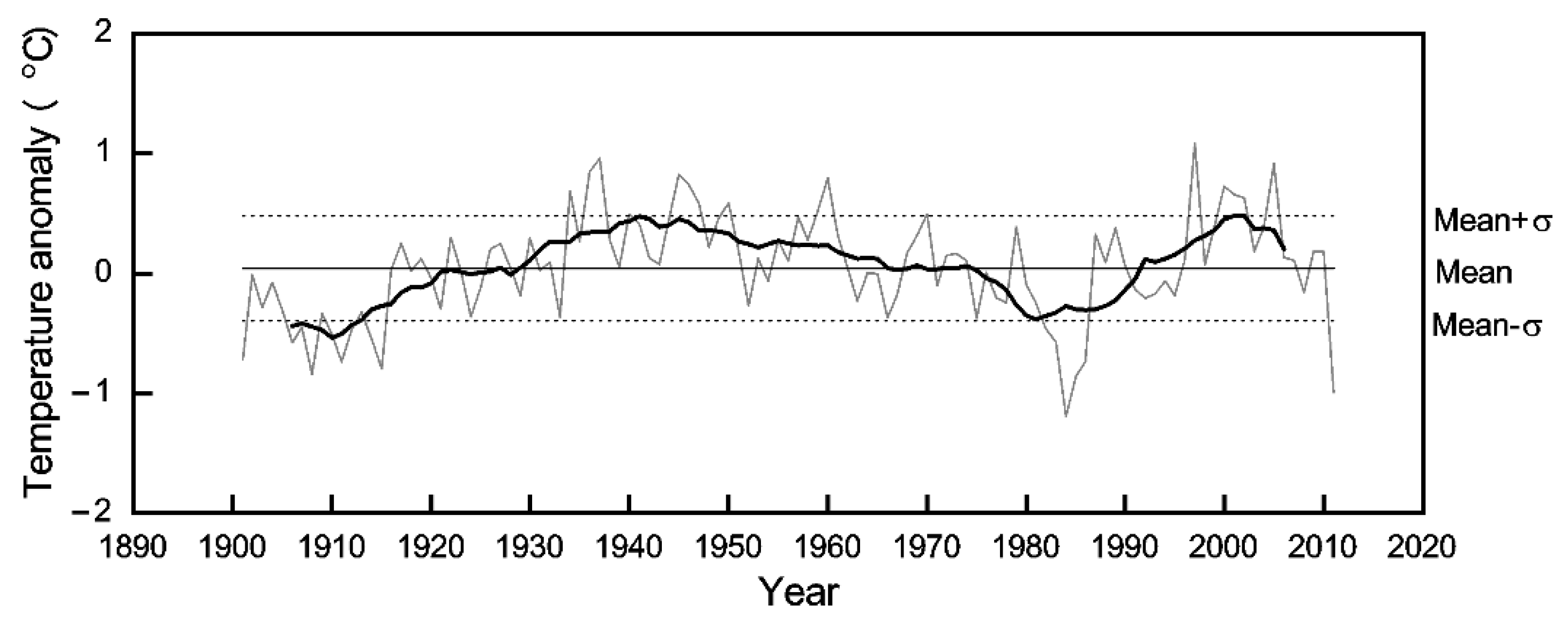
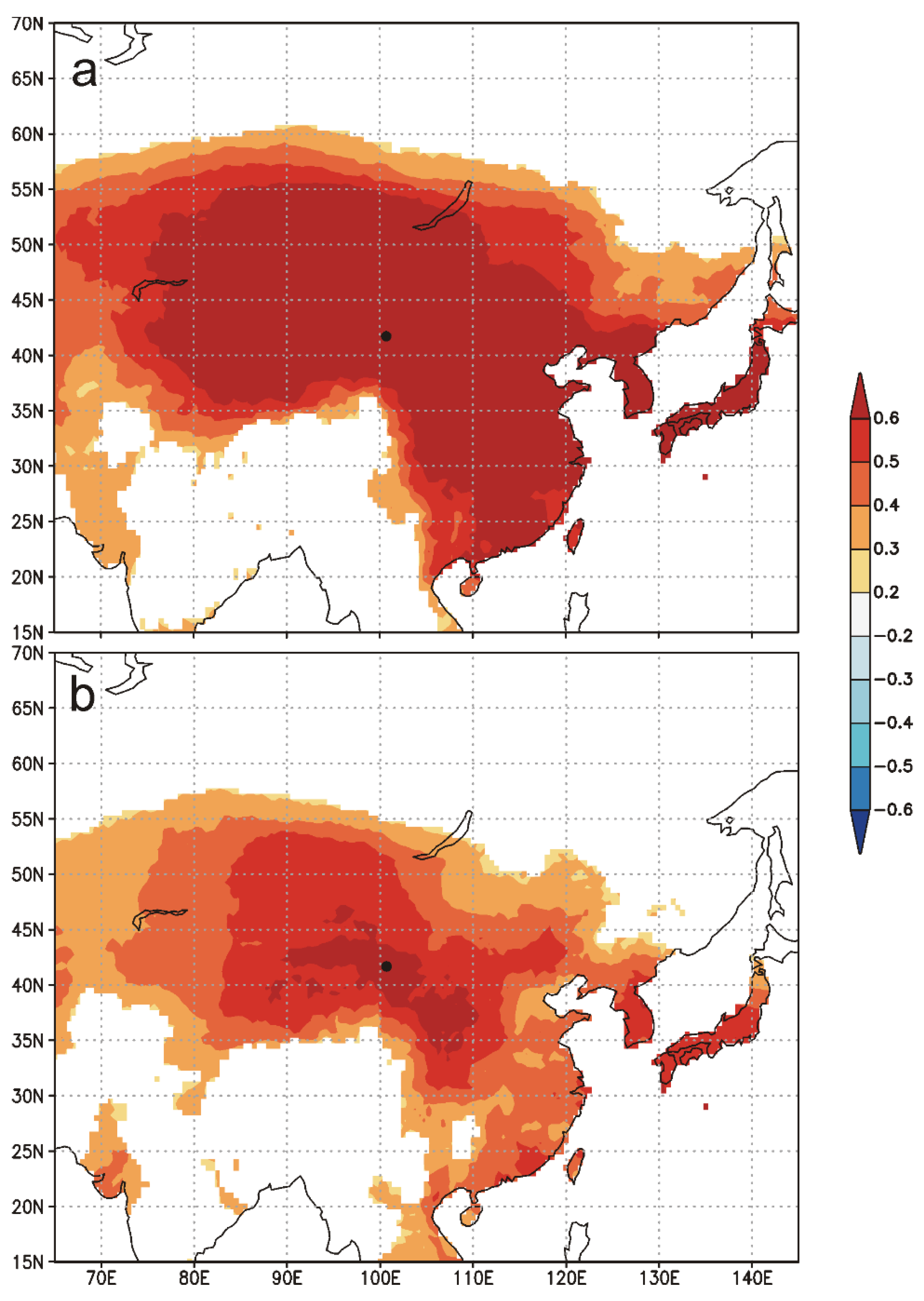
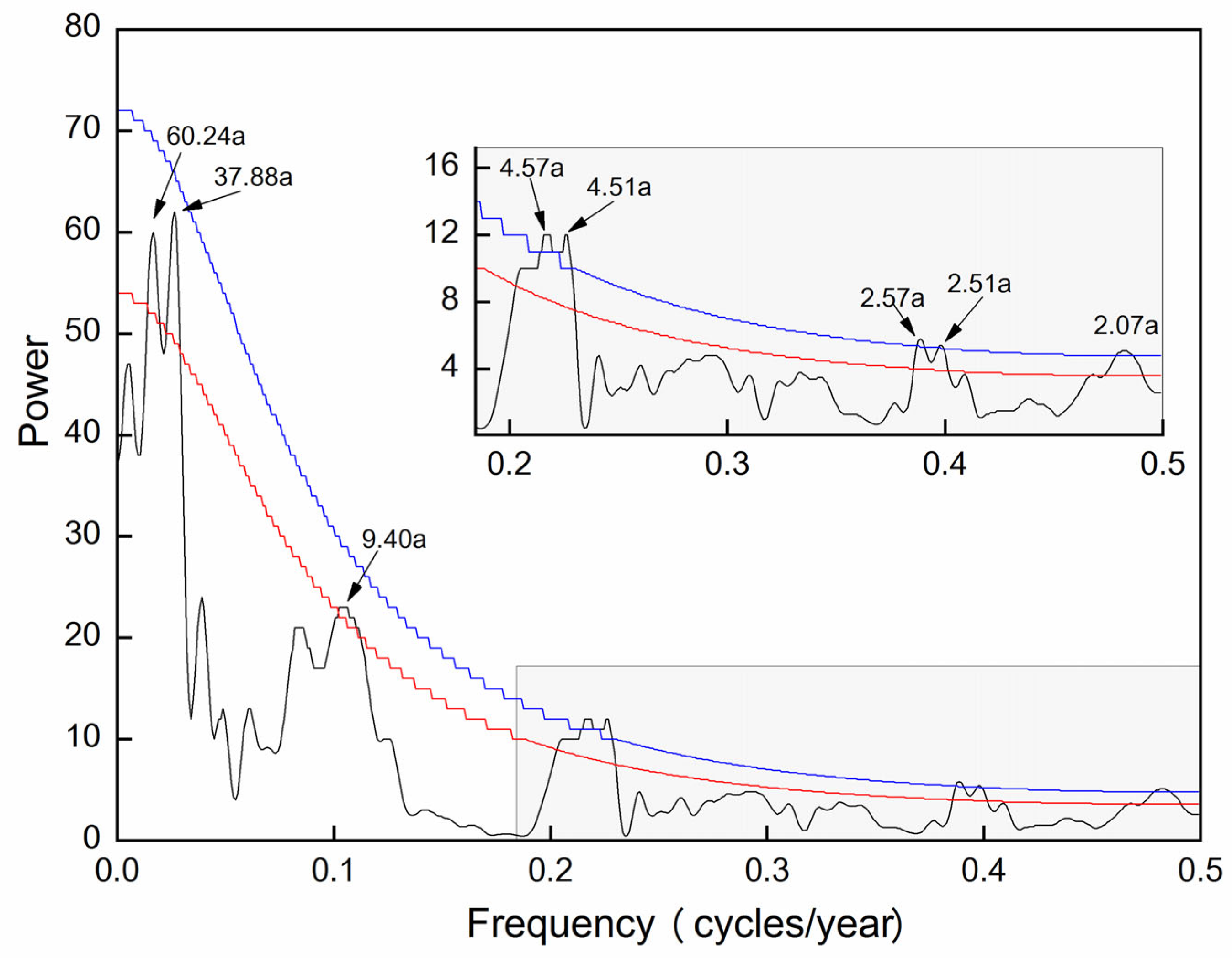


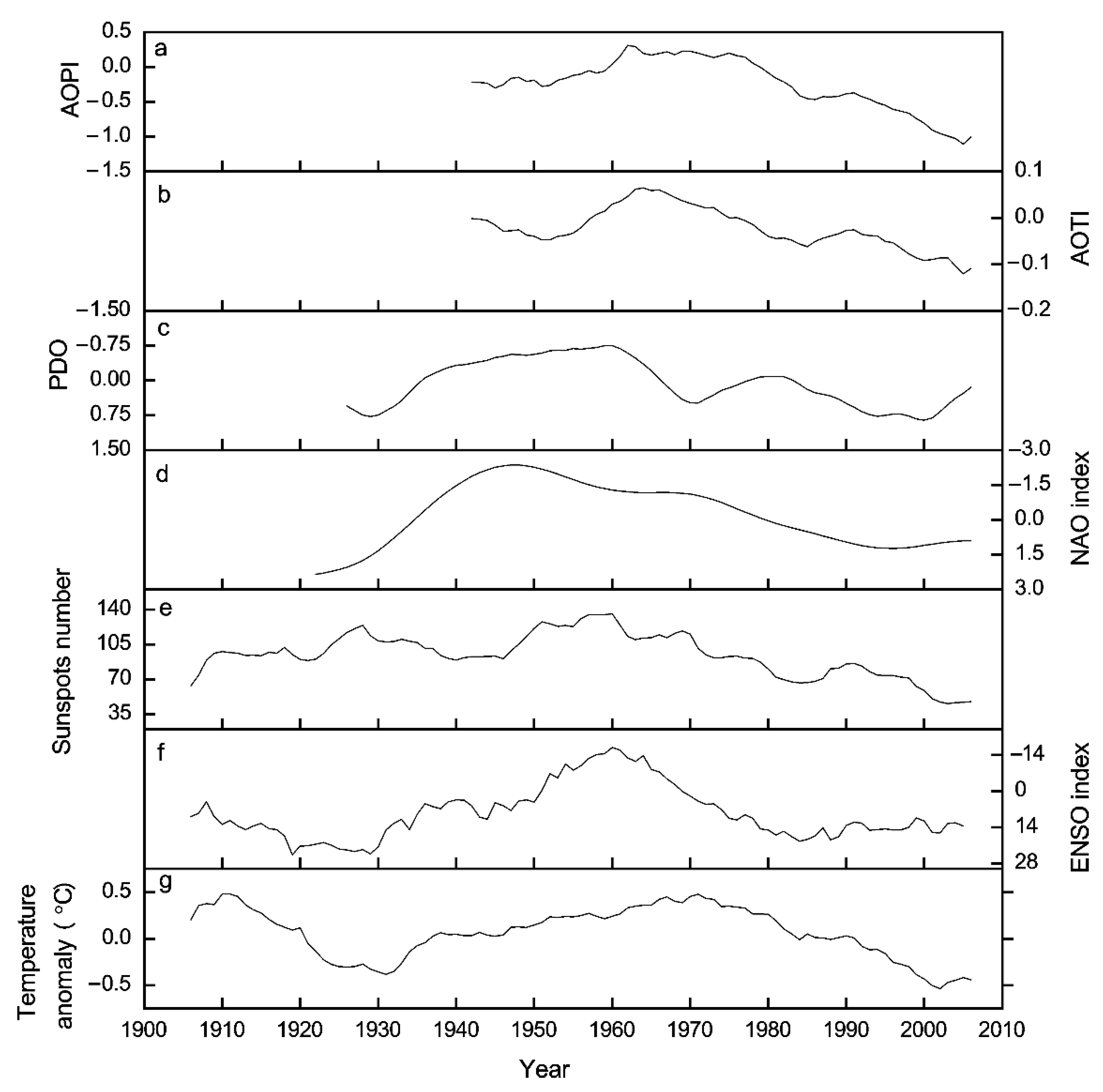
| Item | 06-01B | 06-03B | 06-04A |
|---|---|---|---|
| 06-01B | 1 | 0.518 ** | 0.539 ** |
| 06-03B | 1 | 0.483 ** | |
| 06-04A | 1 |
| Codename | δ13C | ∆13C |
|---|---|---|
| First-order autocorrelation | 0.881 | 0.577 |
| Minimum | −27.706‰ | 17.492‰ |
| Maximum | −24.813‰ | 19.011‰ |
| Mean | −25.806‰ | 18.187‰ |
| Standard deviation | 0.575 | 0.291 |
| Variance | 0.331 | 0.085 |
| Skewness | −0.722 | 0.196 |
| Kurtosis | −0.002 | 0.179 |
| Coefficient of variation | −0.022 | 0.016 |
| Period | S1 | S2 | t | RE |
|---|---|---|---|---|
| 1974–2011 | 26 * | 21 | 3.649 ** | 0.436 |
| Statistical Items | Calibration | Calibration Bootstrap (80 Iterations) | Jackknife |
|---|---|---|---|
| Mean (Interval) | Mean (Interval) | ||
| r | 0.660 | 0.66 (0.39–0.79) | 0.66 (0.62–0.68) |
| R2 | 0.436 | 0.44 (0.15–0.62) | 0.44 (0.39–0.46) |
| R2adj | 0.420 | 0.42 (0.13–0.61) | 0.42 (0.37–0.45) |
| σ | 0.557 | 0.55 (0.43–0.65) | 0.57 (0.55–0.58) |
| F | 27.779 | 30.33 (6.36–59.67) | 27.05 (21.89–30.05) |
| p | 0.001 | 0.00 (0.00–0.02) | 0.00 (0.00–0.00) |
| D/W | 1.993 | 1.92 (1.47–2.10) | 1.99 (1.67–2.19) |
Publisher’s Note: MDPI stays neutral with regard to jurisdictional claims in published maps and institutional affiliations. |
© 2022 by the authors. Licensee MDPI, Basel, Switzerland. This article is an open access article distributed under the terms and conditions of the Creative Commons Attribution (CC BY) license (https://creativecommons.org/licenses/by/4.0/).
Share and Cite
Wang, Y.; Li, Q.; Liu, Y.; Duan, X.; Sun, C.; Song, H.; Cai, Q.; Liu, X. Tree-Ring Stable Carbon Isotope-Based Mean Maximum Temperature Reconstruction in Northwest China and Its Connection with Atmospheric Circulations. Forests 2022, 13, 1815. https://doi.org/10.3390/f13111815
Wang Y, Li Q, Liu Y, Duan X, Sun C, Song H, Cai Q, Liu X. Tree-Ring Stable Carbon Isotope-Based Mean Maximum Temperature Reconstruction in Northwest China and Its Connection with Atmospheric Circulations. Forests. 2022; 13(11):1815. https://doi.org/10.3390/f13111815
Chicago/Turabian StyleWang, Yanchao, Qiang Li, Yu Liu, Xiangyu Duan, Changfeng Sun, Huiming Song, Qiufang Cai, and Xin Liu. 2022. "Tree-Ring Stable Carbon Isotope-Based Mean Maximum Temperature Reconstruction in Northwest China and Its Connection with Atmospheric Circulations" Forests 13, no. 11: 1815. https://doi.org/10.3390/f13111815
APA StyleWang, Y., Li, Q., Liu, Y., Duan, X., Sun, C., Song, H., Cai, Q., & Liu, X. (2022). Tree-Ring Stable Carbon Isotope-Based Mean Maximum Temperature Reconstruction in Northwest China and Its Connection with Atmospheric Circulations. Forests, 13(11), 1815. https://doi.org/10.3390/f13111815









